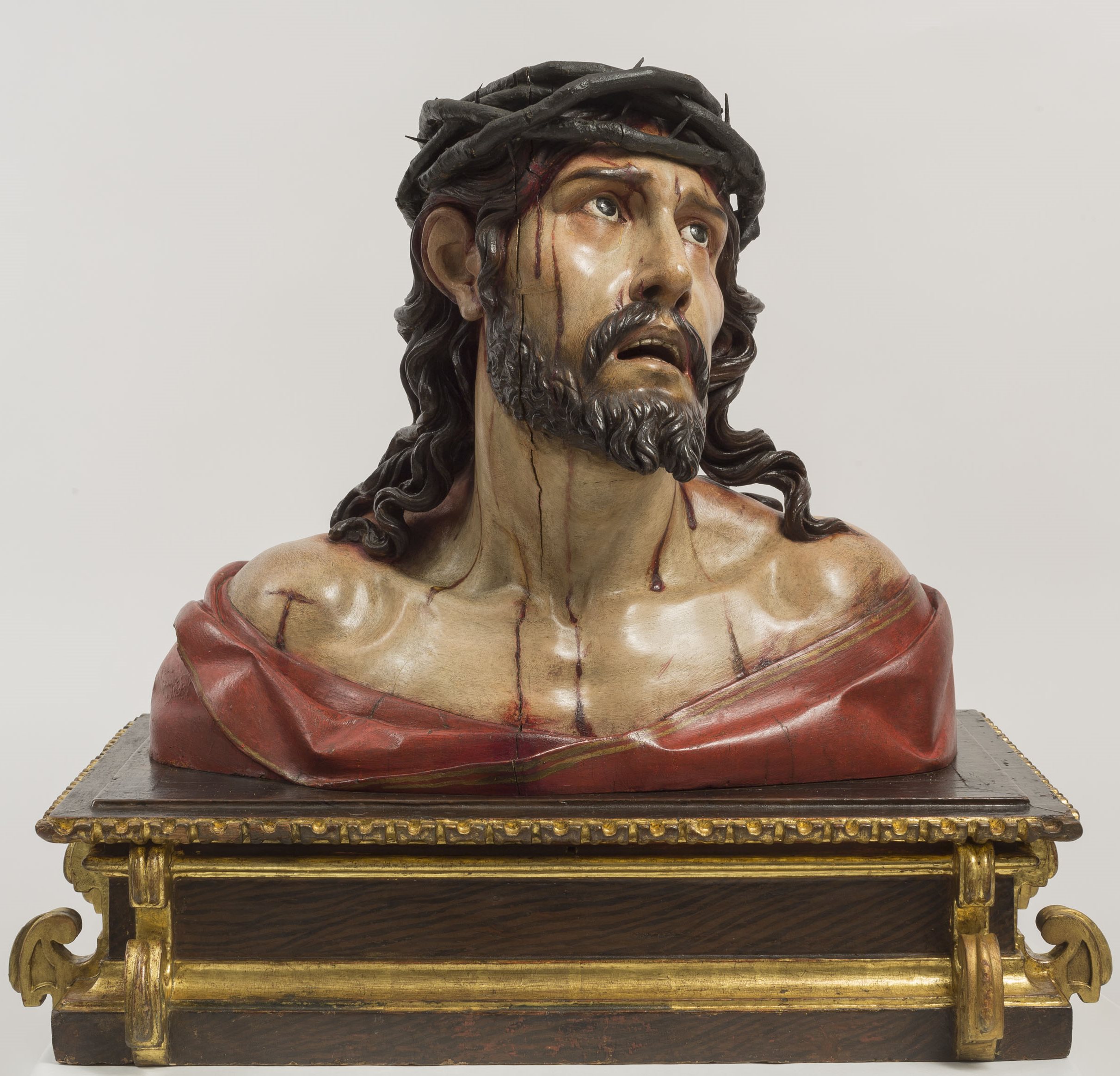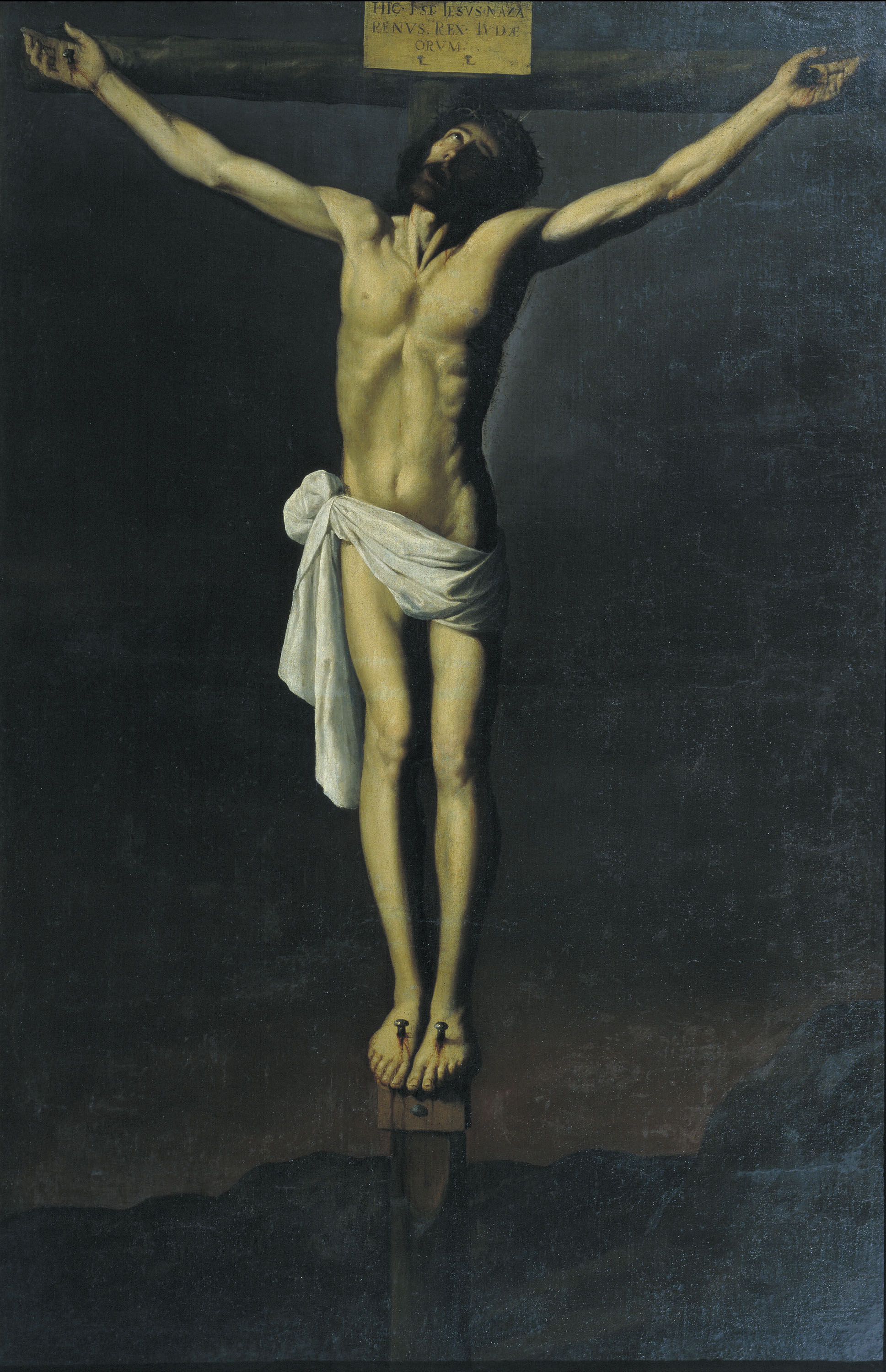In Holy Week we invite you to come and visit the scenes of the Passion and the death of Christ in works in the museum’s Renaissance and Baroque collection, some of which can be seen in the new display.
From Jesus’ Entry into Jerusalem to the Flagellation of Christ
According to the gospels, Jesus, followed by the Apostles, came down from Bethany to Jerusalem sitting on a donkey, and the people of the city came out to meet him singing.
When Jesus entered the temple in Jerusalem, he was annoyed by the merchants and money-changers who were everywhere, profaning the sanctuary. It is the scene known as the The Expulsion of the Money-changers from the Temple painted by Tiepolo in the following work:

Giandomenico Tiepolo, Expulsion of the Money-changers from the Temple, 1750-1753
The action is depicted in a very theatrical way, through the gestures and the expressions of the figures, as well as numerous details. Colour plays an important part in it because the shade and the use of contrast creates illusionistic effects.
The Last Supper. It is the last meal that Christ ate with the 12 apostles before Judas betrayed him. This alabaster carving comes from the Carthusian priory of Escaladei (La Morera de Montsant, Priorat):

Isidre Espinalt, The Last Supper, 1695
The Washing of the Feet. In the Middle East it was the custom to wash the guests’ feet before serving a meal. Jesus wished to teach his disciples a lesson in humility, voluntarily performing a task that was normally done by slaves.

Pere Pau Montaña Llanas, The Washing of the Feet, 1780. Work not on display
Jesus Praying in the Garden of Gethsemane. The capture (arrest) has, as a prelude, Jesus’ prayer on the Mount of Olives, in Gethsemane.

Ramon Amadeu, Jesus Praying in the Garden of Gethsemane, around 1809-1821
Ramon Amadeu was a late 18th-century sculptor well known for his Nativity scene figurines. Jesus praying in the Garden of Gethsemane is a figure that resembles his Nativity scene figurines.
Judas’ Betrayal and the Arrest of Jesus. Judas kisses Jesus, a gesture that enables the armed guards charged with arresting Christ to identify him, an act agreed upon to avoid any mistakes. After betraying Jesus, we see the episode of the remorse and despair of Judas, who commits suicide by hanging himself from a fig tree.
This work has a peculiar story behind it. It is of the apostle Judas Iscariot, who hanged himself from a fig tree. Upon hanging himself, his belly opened, and his black entrails and filthy soul spilled out (it did not issue from his mouth, as he had kissed Christ). The work entered the museum in 1932 as a part of the frontal from Santa Maria in Taüll, from the lower right-hand compartment. However, photographs exist of when this work was discovered, in the early 20th century, in which Judas does not appear. The small figure of Judas must have been a complement placed during the restoration work done by Arturo Cividini in 1924, before selling the frontal to Mr Plandiura. Judas did not stay on the frontal for long, as he was removed in restoration work done in 1943.
The Interrogation. In actual fact there are two interrogations of Jesus Christ, the Jewish one and the Roman one, or, in other words, the religious one and the political one. Jesus appears before two jurisdictions: that of the high priest (Jesus before Caiaphas) and that of the Roman procurator (Jesus before Pilate).
Then comes the scene of the flagellation of Christ, tied to a column, which was not designed to torment Christ; Pilate thought that by doing this he would placate the people’s anger and save him. This scene has been widely reproduced in art.

Anonymous, The Flagellation of Christ, 1585
The Crown of Thorns is an instrument of torture and a sign of ridicule; Christ is not treated as a false God but as a Carnival king. Finally, Pilate presents Jesus before the multitude that have gathered in front of the Praetorium, saying (John 19: 4): Behold the Man (Ecce Homo).
In Morales’ Ecce Homo, Christ is shown in the solitude of the moment when he is condemned to death before the multitude at the Praetorium. Morales’ Ecce Homos were very popular, and proof of that are the multiple versions that are known of it, whether by the artist himself, by his workshop, or copies.
The Crucifixion
Why was Christ sentenced to be crucified? As a blasphemer he had to endure the Jewish punishment of stoning, like Saint Stephen. A Roman citizen, like Saint Paul, had to be beheaded with a sword. But as he was neither one thing nor the other, he suffered a punishment that was reserved for slaves who had run away or rebelled against their master: crucifixion.
In The Way to Calvary by Hans van Wechelen it is difficult to pick out the figure of Jesus Christ in the crowd. It is a 16th-century Flemish painting, a very detailed work that highlights the landscape and the details
El Greco’s Christ Carrying the Cross allows us to admire the painter’s characteristic brushwork, with which he models the volumes with the colour and distorts the bodies to reflect the figures’ spiritual unease. The cross that Christ carries symbolizes his triumph over death and not an instrument of martyrdom. The face does not reflect pain, but serenity and a gaze trusting in eternal life.

Giambatistta Tiepolo, Christ on the Way to Golgotha, after 1738
The image of Christ dead on the cross is the emblem and the guarantee of salvation, the central theme of Christianity. Images of the Crucifixion:
This is one of the many crucifixion scenes by Zurbarán focusing on the presence of Christ nailed to the cross with four nails, an iconographical theme that the guardians of the Inquisition in Seville established in this way (led by Francisco Pacheco). The figure is very naturalistic and is achieved through the dramatic use of the light.
The Lamentation of Christ
Under this general title four scenes are grouped together: the descent from the cross, the deposition, the lamentation and the burial

Marcellus Coffermans, Descent from the Cross, Third quarter of the 16th century
Coffermans’ Descent from the Cross still follows the Flemish painting tradition of the great 15th-century masters.

Paolo da San Leocadio, Mourning Over the Dead Christ, around 1507
Paolo da San Leocadio is an Italian painter who came to Valencia with the entourage of the man who was then still Roderic de Borja (Rodrigo Borgia), the future Pope Alexander VI. He established himself there and was a point of reference for the new generations like, among others, Joan de Joanes and Vicenç Massip.
Burial. Joseph of Arimathea, whom Pilate had granted permission to remove the body of Christ, wrapped it in a shroud and placed it in a sepulchre that he had had dug out of a rock, in the rock of Golgotha. He then covered the entrance with a stone
The Resurrection
It is one of the most important dogmas of the Christian religion. Faith in a god that dies and is brought back to life is not exclusive to or specifically Christian. It is a universal belief that we find in the majority of ancient religions (the Egyptians, in the worship of Osiris; the Syrians, in the worship of Adonis). It seems to have been inspired by the changing of the seasons, the rebirth of vegetation after the death of winter; Christian Easter also coincides with the reawakening of spring.
The Resurrection is one of the four surviving compartments of an altarpiece dedicated to Christ, by Bartolomé Bermejo, a painter from Cordoba who did his best-known work in the Crown of Aragon. Bermejo’s work, characterized by realism free of idealizations, incorporates some new ideas from northern European painting, like the use of oil as an agglutinant, replacing egg tempera. In this compartment, Christ emerges from the sepulchre before the adoring gaze of an angel, while the soldiers watching over the tomb are terrified by the miracle. In the background we see the three Marys, who have left Jerusalem and are walking towards the sepulchre with jars of perfume to anoint the body of Christ.
The Ascension, a work signed and dated by Francisco Camilo, shows the eclecticism of painting in Madrid in the mid 17th century, in which we find a combination of the effectism of triumphant Baroque and some influences from Venetian painting, which the painter must have seen in the royal collection.

Martin Bernat, Processional cross with the bust of Christ and the Arma Christi, 1477-1505
This processional cross, attributed to Martin Bernat, which is in the Gothic art collection, but is chronologically on the threshold of 1500, includes many of the scenes from the Passion of Christ.
On one hand, the bust of Christ crowned with thorns appears, and his bloody hands and feet due to the nails of the crucifixion, symbols of the messiah. On the other, the instruments of the Passion: the cockerel of Peter’s denial, the column of the flagellation and two scourges, Longinus’ lance, the rod with the sponge and the jug of vinegar, the lantern of Christ’s arrest, the dice with which the soldiers played for Christ’s clothes, the cohort’s trumpet, the pincers and the hammer. On the knife with which Saint Peter cut off Malchus’ ear, notice the clover that appears on the leaf, the mark of the blacksmiths’ guild, and also an element associated with the Trinity.
Happy Easter!
Related links
New display of Renaissance and Baroque
Opening of the new Renaissance and Baroque galleries!


















